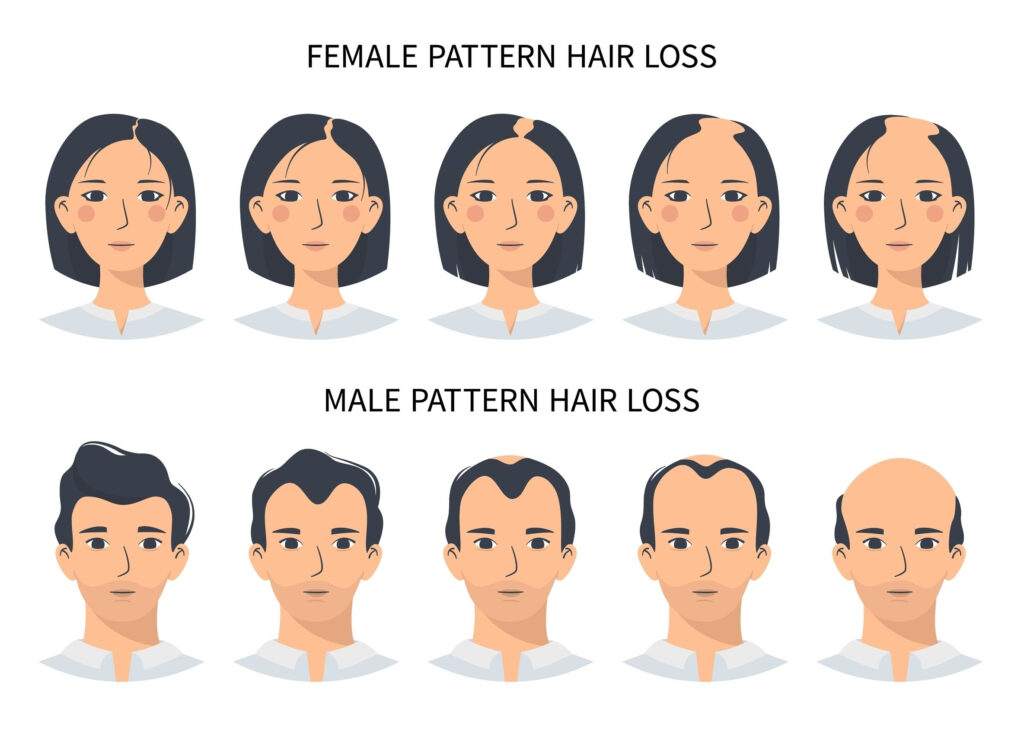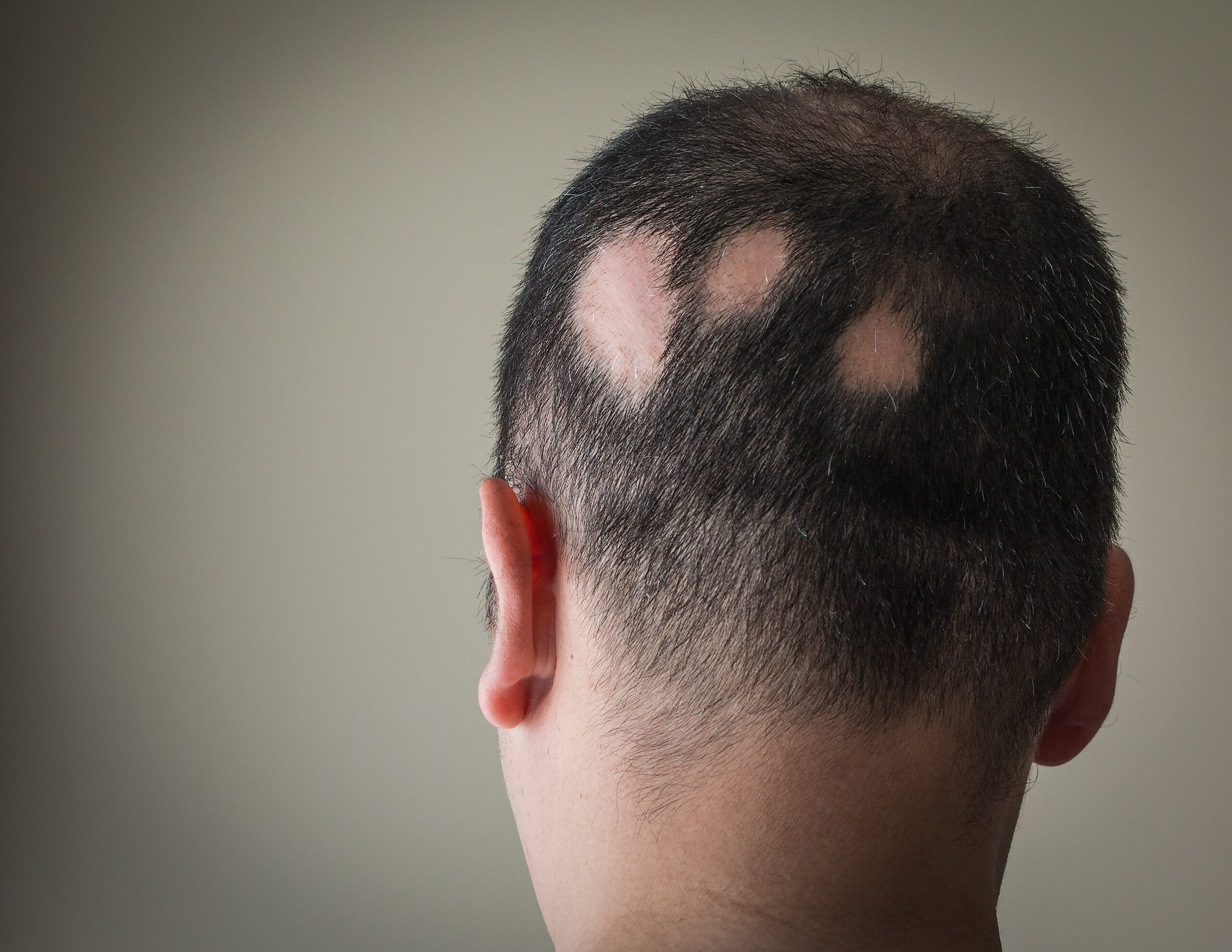In this article we will explore the most common types of alopecia and provide you with some tips on how to identify them. While professionals can use complex devices to examine hair and scalp, we will offer here some visual clues to help you differentiate the patterns. By the end of this article, you will have a better understanding of alopecia, which types can be cured, and how to seek appropriate treatment.
1. ANDROGENETIC ALOPECIA (AGA)
To understand androgenic alopecia, it is helpful to break down its name:
- Androgens are male sex hormones that play a key role in this condition. Specifically, hormone DHT, Dihydrotestosterone, which derives from testosterone is the main trigger. While DHT is a necessary hormone, an excess of it can lead to hair loss.
- Genetics, because it can be hereditary. People with a family history have more chances to have it.
It can affect both men and women, but it is more common in men due to their higher levels of testosterone.
Androgenic alopecia shows different patterns for men and women, but in both cases hair loss occurs primarily on the top of the head, as it is where hair follicles with testosterone receptors are concentrated.
MALE PATTERN BALDNESS
While male pattern baldness typically begins to show in a man’s forties, it can actually start as early as the late teens or twenties. The first sign is often a receding hairline, which takes on an M shape, and thinning hair at the top of the head. As the condition progresses, the hair also falls out at the crown, and eventually the receding areas and the bald patch meet, forming a U-shaped pattern. This leaves a rim of hair around the sides and back of the head.
WOMEN PATTERN BALDNESS
Women of any age can suffer from AGA, but it is more common after menopause, as it is then when women produce fewer estrogens, which are testosterone antagonists. It causes testosterone to increase, in some cases triggering androgenetic alopecia.
It begins with hair thinning at the part line, followed by diffuse hair loss at the top. Complete bald areas rarely develop.

Treatments for AGA focus on the inhibition of DHT. With the right treatment, it can be controlled but not reversed. It means that people with AGA should always treat it, or their hair will fall again.
2. ALOPECIA AREATA
It is an autoimmune disease in which the immune system attacks the follicles, causing the hair to fall out. The term Areata comes from the Latin word “area”, which means vacant space or patch. As its name suggests, the most common pattern for this type of alopecia is the formation of bald round patches on the scalp, and only in very severe cases the hair can fall out completely.
It can affect women and men equally and at any age, but it is more common in people with a genetic predisposition (having a family history), or those who suffer from an autoimmune disease like a thyroid disorder, psoriasis, or vitiligo.
While it is difficult to know the trigger, stress seems to be usually related. Although sometimes this type of alopecia can resolve spontaneously when the triggering agent is controlled (e.g. accurate stress), finding a treatment ASAP is highly recommended. Alopecia areata can be reversed with proper treatment.

3. DIFFUSE ALOPECIA
This type of alopecia causes gradual thinning of hair, loss of density, and diffuse hair loss around the whole head.
It can be triggered by several reasons: iron deficiency, nutritional deficits, post-partum, stress, hormonal alterations, certain diseases, use of anticoagulants, and cancer treatments.
The first step for treating this type of alopecia is finding the trigger. Once the origin is treated and resolved, hair loss should stop. Nevertheless, following a treatment that helps to nourish and strengthen your hair is highly recommended.
4. SCARRING OR CICATRICIAL ALOPECIA
This type of alopecia is, fortunately, not as common as the ones mentioned above, and it is the one that does not have a cure yet.
As the name implies, this type of alopecia comes with scarring. There are two types: primary and secondary.
Primary scarring alopecia is an inflammatory condition that results in permanent hair follicles due to the destruction of hair follicles. Follicle destruction and scarring occur below the skin’s surface, so usually the only sign is the lack of hair accompanied by redness, mild inflammation, or pustules. It can come with itching or burning sensation.
It can be triggered by autoimmune disease, bacterial infection, or lichen planopilaris, which is a type of dermatosis. Although primary scarring alopecia can affect anybody at any age, it seems to be more common among black women over the age of 50.
Secondary scarring alopecia is caused by scalp injury, such as burn or trauma that forms a scar on the surface that destroys the hair bulb.
Hair implants on scars are more difficult than on healthy tissue, but some cases have shown favorable results. It seems burn scars have more probability of success than other scars.
TO SUM UP
Alopecia is a multifactorial condition not easy to deal with, and treatment may vary according to the type of alopecia you are facing. Nevertheless, what all these types of alopecia seem to have in common, is that time is of the essence. Therefore, the faster you identify the underlying cause and find the right treatment, the more chances to retain your hair.



